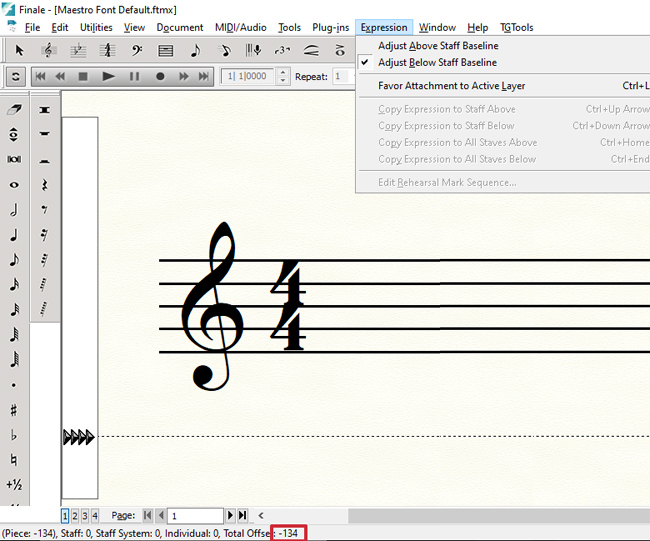General Document Options
PL will
always do the following changes in Finale's document options:
Lines and Curves->Curve Resolution: 127
Double Barline at Key Change: activated (will only happen if there is exactly one key signature change in the score)
Document->Pickup Measure->EDUs: will be corrected if it's an invalid value (You will get a warning message from PL)
Layers->Consolidate Rests Across Layers: activated (if Optimize->Force Consolidated Rests is activated)
Accidentals->Minimum Vertical Spacing Between Accidentals: 6 (but only if the original value was less than 6), on huge jazz fonts it will set it to 7.
Accidentals->Space within Multi-Character Accidentals: 6 EVPU (but only if the original value was less than 4 EVPU and it is a font with a large "Advance Width" offset, e.g. Opus Std)
Accidentals->Use cross-layer accidental positioning: activated (but only if you use RGP Lua. On JW Lua you get a warning message that you have to activate it manually)
Line Thickness
The line thickness looks best when the lines use certain proportions.
You can use your own proportions.
But if the staff line thickness and the stem line thickness are identical, and the ledger line and the thin barline thickness are identical, then PL will use these values instead:
Lines and Curves->Ledger Line Thickness: 256 EFIX = 4 EVPU
Lines and Curves->Staff Line Thickness: 190 EFIX = 2.96875 EVPU
Barlines->Thin Barline Thickness: 245 EFIX = 3.8281 EVPU
Stems->Stem Line Thickness: 170 EFIX = 2.65625 EVPU
Tie Settings
If
Optimize->Optimize Tie Settings is activated:
Use Outer Placement: activated
Start After Single Dot: activated
Start After Multiple Dots: activated
End Before Single Accidentals: activated
Break For Time Sigs: activated
Break For Key Sigs: activated
Seconds Placement: Shift for seconds on start and end of tie
Time Sig Left Gap: 12 EVPU
Time Sig Right Gap: 12 EVPU
Key Sig Left Gap: 12 EVPU
Key Sig Right Gap: 12 EVPU
System Start Adjustment: -8 EVPU
System End Adjustment: 0 EVPU
Extra System Start Space: 8 EVPU
Direction Opposing Seconds: activated
Direction Type: Split Evenly
Tie Contour->Interpolate Height: activated
Tie Contour->Avoid Staff Lines: activated
Tie Contour->Avoid Staff Lines Distance: 10 EVPU
Tie Contour->Avoid Staff Lines In Staff Only: activated
Tie Contour->Thickness Left/Right: 6 EVPU (but only if the original value was less than 6 EVPU)
Tie Contour->Tip Width: 1 EVPU (but only if the original value was less than 1 EVPU)
Tie Contour->Inset Style: Percent
Slur Settings:
Use Engraver Slurs: activated (PL doesn't work with non-engraver slurs)
If
Optimize->Optimize Slur Settings is activated:
Space Around Objects: 10 EVPU
Avoid Accidentals: activated
Space Around Accidentals: -4 EVPU
Max Slur Angle: 52
Slur Symmetry Percentage: 3%
As Percentage of Slur Length: activated / 15%
Maximum Lift: 24
Lift: activated
Articulations Avoid Slurs by: 3 EVPU (Only in Perfect Layout 4+ with Finale 26.2-27/RGP Lua only and with "Reset Vertical Position of Note Articulations" activated)
Slur Tip: Tips Avoid Staff Lines by 8 EVPU / activated
if
Slur Thickness Vertical Left is less than 7 EVPU:
Slur Thickness Vertical Left: 7 EVPU
Slur Thickness Vertical Right: 7 EVPU
Slur Thickness Horizontal Left: 0 EVPU
Slur Thickness Horizontal Right: 0 EVPU
Slur Tip Width: 1.4 EVPU
if
Optimize->Optimize Slur System Breaks is activated:
Avoid Staff Lines by at Least: the value from the Optimize dialog (32 EVPU by default)
System Stadt Adjustment: -12 EVPU
System End Adjustment: 0 EVPU
Multi-Measure Rest Settings
Multi-Measure Rest Auto Update: deactivated (this is mandatory)
If
MMRests->Force Classical Look is activated:
Multi-Measure Rests->Start Numbering At: 1 Measures
Multi-Measure Rests->Use Symbols: activated
Multi-Measure Rests->Use Symbols for Rests less than: 9 Measures
Multi-Measure Rests->Space Between Symbols: 24 EVPU
If
MMRests->Set 'Start Numbering At' to Two Measures is activated:
Multi-Measure Rests->Start Numbering At: 2 Measures
Hairpin Settings
If
Optimize->Optimize Hairpin Settings is activated:
Hairpin Line Width: 192 EVPU (but only if the original value was less than 116 EVPU)
When using exponential hairpin expressions, the Hairpin Line Width value will be automatically adjusted according to the used music fonts.
Hairpin Opening Width: 28 EVPU (according to the value under
Optimize->Hairpin Default Opening Width)
Hairpin Short Opening Width: 28 EVPU (same value as Opening Width)
Tuplet Settings
If
Optimize->Optimize Tuplet Settings is activated:
Default Placement: Stem/Beam Side (on jazz/handwritten music fonts where 'Above' was selected, this will not be changed)
Engraver Tuplet: activated
Avoid Staff: take the value from the Optimize dialog (activated by default)
Allow Horizontal Drag: deactivated
Use Bottom Note: deactivated
Vertical Tuplet Offset: 28 EVPU
Vertical Shape Offset: 0 EVPU
Horizontal Tuplet Offset: 0 EVPU
Horizontal Shape Offset: 0 EVPU
Ignore Number Offset: deactivated
Bracket Full Duration: deactivated
Match length of hooks: activated
Left Hook: 16 EVPU
Right Hook: 16 EVPU
Left Extension: 0 EVPU
Right Extension: 0 EVPU
Manual Slope Adjustment: 0 EVPU
Number Style: Regular (but only if it was set to None)
Shape Style: Bracket (but only if if it was set to None)
Break Slur or Bracket: activated
Bracket Mode: Never bracket beamed notes on beam side
Number Offset Upstem Side of Note: 12 EVPU
NumberOffset Downstem Side of Note: -12 EVPU
Max Slope: 10 Degrees
(The bracket thickness is not changed)
Music Spacing Settings
If
Optimize->Optimize Spacing Settings is activated:
Notes and Rests->Scale Manual Note Positioning: deactivated
Music Spacing->Minimum Item Distance: 12 EVPU
Music Spacing->Grace Note Min Distance: 12 EVPU
Music Spacing->Grace Note Spacing Mode: automatic
Music Spacing->Min Measure Width: 150 EVPU
Music Spacing->Max Measure Width: 2000 EVPU (if it was above 2000), otherwise 1800 EVPU
Music Spacing->Min Distance with Ties: 38 EVPU
Music Spacing->Avoid Collision of Clefs: activated
Music Spacing->Avoid Collision of Lyrics: activated
Music Spacing->Avoid Collision of Notes and Accidentals: activated
Music Spacing->Avoid Collision of Seconds: activated
(the other "Avoid Collision Of" values are restored to the original values after running the plug-in)
If "
Finale Document Options->Music Spacing->Spacing Widths->Use these values" is activated, PL changes the Spacing Widths values to Finale's default settings:
Reference Width: 84 EVPU
Reference Duration: 1024
Scaling Factor: 1.6179








